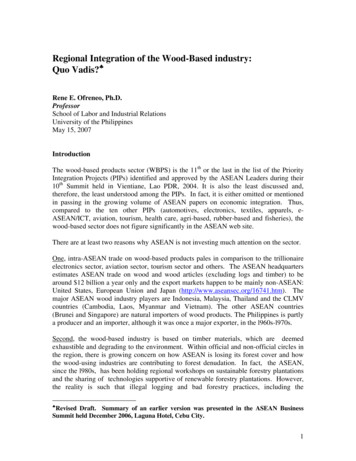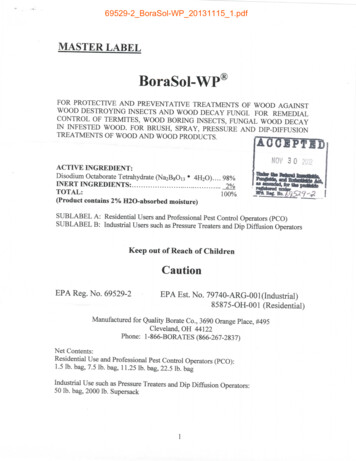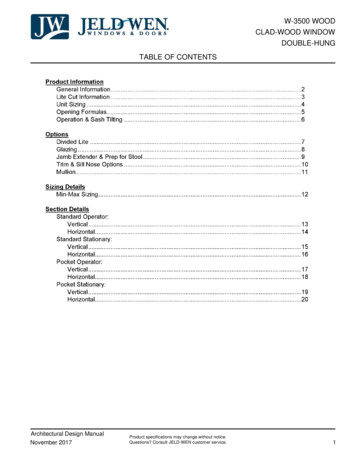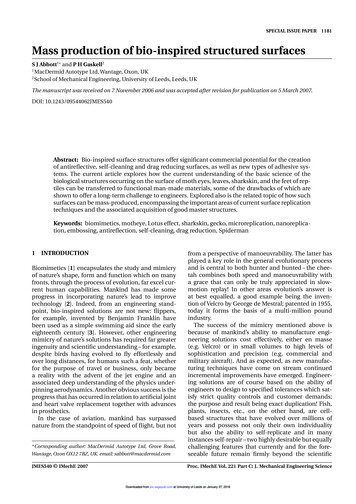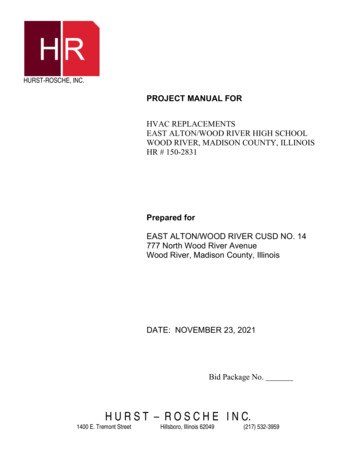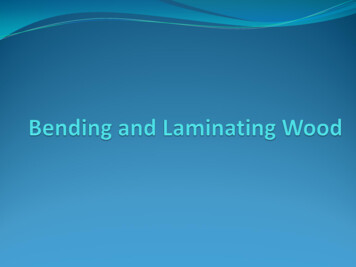Transcription
WOOD RESEARCH63 (2): 2018353-364FABRICATION OF SUPERHYDROPHOBICWOOD SURFACEWITH A SILICA/SILICONE OIL COMPLEX EMULSIONZhi LiuBeijing Forestry University, College of Material Science and TechnologyMoe Key Laboratory of Wooden Material Science and ApplicationBeijing, ChinaHebei Agriculture University, College of ForestryDepartment of Wood Science and EngineeringBaoding, ChinaJinzhen CaoBeijing Forestry University, College of Material Science and TechnologyMoe Key Laboratory of Wooden Material Scienceand ApplicationBeijing, China(Received April 2017)ABSTRACTThe superhydrophobic wood surface was fabricated in this study by impregnating oven-drypoplar (Populus cathayana Rehd.) samples with a silica/silicone oil complex emulsion (SSOCE),mainly composed of two silicone oils(hydroxy silicone oil and hydrogen silicone oil) and twodifferent sized silica particles (micron and nano scaled, respectively). Different concentrationsof the complex emulsion (5%, 10%, 20%, 30% and 40%) were used and their effect on staticcontact angles (CAs) and surface free energy (SFE) of wood were investigated. The chemicaland morphological changes of modified wood surface were characterized by attenuated totalreflection Fourier transform infrared spectroscopy (ATR-FTIR), atomic force microscope(AFM) and X-ray photoelectron spectroscopy (XPS). The superhydrophobic wood surfaces weremanifested by the water CA of about 154.8 on the transverse section, 151.3 on the tangentialsection and 150.2 on the radial section, respectively. It was confirmed that silicone oilsin thecomplex emulsion formed a silicon resin filmand uniformly attached on the wood surface, withsilica particles in micron and nano scales helped to make the surface rougher.KEYWORDS: Wood, silicone oil emulsion, silica particle, superhydrophobicity, contact angle.353
WOOD RESEARCHINTRODUCTIONRecently, many botanists focused their research on the microrelief of plant leaf surfaces,and found that epicuticular wax crystalloids and surface roughness are the main causes for selfcleaning and water repellent mechanism of many biological surfaces. For example, the lotus leafis highly water-repellent with a contact angle above 150 and a rolling angle below 10 , so theparticles on it can be removed completely by water droplets that roll off the surfaces, independentof their chemical nature and size of surface roughness. This effect is called the “Lotus-Effect”,which has attracted significant attention in academic research, industrial applications and dailylife uses over the last two decades (Satoshi et al.1996, Barthlott et al. 1997, Abraham 2004,McHale et al. 2005, Zhang et al. 2013, Wang et al. 2015).The fabrication of artificial superhydrophobic surfaces on wood has aroused a considerableamount of interest from academia (Liu et al. 2011a, Fu et al. 2012, Kavalenka et al. 2014,Chu et al. 2015, Jin et al. 2015). Various techniques have been used such as the self-assemblymethod (Lu et al. 2013, Jin et al. 2014), hydrothermal method (Sun et al. 2011, Fuet al. 2012,Gan et al. 2015, Liu et al. 2015), chemical reaction and deposition method (Jin et al. 2015), andsol-gel method (Donath et al. 2004, Wang et al. 2011, Wang et al. 2013, Lu et al. 2013, Gaoet al. 2015). However, some treatment procedures and requirements(involved harsh conditions,expensive and harmful compounds, specialized reagents and equipment, etc.) appeared to be toocomplicated to be feasible in practice.A wide variety of organo-silicon compounds has been studied for application on wood.Some organo-functional silanes such as 3,3,3-trifluoropropyltrimethoxysilane (TFPTMOS)were combined with tetraalkoxysilanes (TEOS) to impregnate wood in one step (Mai andMilitz 2004). However, various physical and chemical factors (e.g. temperature, pH value ofthe catalyst, H 2O:Si ratio) cause variation in the process of hydrolysis and condensation, as wellas in the structure of the obtained products. Hydrolysis and condensation reaction never reachcompletion even if an excess of water was available so that a polysilicate mixture of intermediatespecies was formed (Donath et al.2004). Therefore, the reaction conditions were complex, thequality of modified wood was difficult to be controlled and the time required for the experimentwas relatively long.Silicone oilswere widely applied in industrial products due totheir unique properties ofhigh lubricity, non-toxicity, extensive spreading, and stable film formation (Clarson et al.2007). Silicone oils as an organo-silicon compound were important water repellents that imparthydrophobicity to wood products (Mai and Militz 2004, Jusoh et al. 2005). The most commonlyused silicones were polydimethylsiloxanes (PDMS), which may have side groups of variousfunctionalities (Oliver et al. 2007). Depending on the functionalisation of the silicone oils, thedegree of hydrophobicity can vary. Primary hydroxyl group and hydrogenous group as part ofa side group increase the affinity of silicone molecules to cellulosic material. The silicone oils, whichwere developed for application in the textile industry, were usually applied in aqueous systemsin the form of macro- or micro-emulsions. The droplet size in these emulsions has significantinfluence on the liquid penetration into wood matrix. The localization of silicone systems inwood and their influence on water uptake and dimensional stabilization are described in recentstudies (Ren et al. 1995, Mai and Militz 2004, Weigen et al. 2007, Vetter et al. 2010). Amongstthe various techniques used for the fabrication of a super-repellent surface, coating substrateswith silica nanoparticles (SNP) was a widely-used one (Rao et al. 2003, Hsieh et al. 2009, Hsiehet al. 2011, Liu et al. 2011b). The nanosilica particles impart roughness to substrate surfaces,which makes a hydrophobic surface become more hydrophobic, or even superhydrophobic.354
Vol. 63 (2): 2018Here, we developed a complex emulsion system and used it to fabrica tea superhydrophobicsurface inside wood after suitable drying process. Compared with the traditional approaches suchassol-gel method, this method is simpler and the procedure is more convenient to operate forensuring the quality of modified wood. In this study, the static contact angles (CAs) and surfacefree energy (SFE) of the control and modified samples were investigated, and the chemicaland morphological alterations of wood surface were characterized by attenuated total reflectionFourier transform infrared spectroscopy (ATR-FTIR), field emission scanning electronmicroscope (FESEM) and X-ray photoelectron spectroscopy (XPS).MATERIAL AND METHODSMaterialsPoplar (Populus cathayana Rehd.) sapwood samples collected from the northeast of Chinawith an air-dry density of 0.382 g.cm-3 and an average growth ring width of 0.35 cm wereused in this study. The sizes of the samples are 20 (L) 20(T) 20(R) mm for testing WPG,bulkingeffect and sorption behavior, 10(L) 20(T) 20(R) mm for ATR-FTIR characterization,5(L) 5(T) 2(R) mm for XPS tests, and 3(L) 3 (T) 3 (R) mm for AFM analyses. Prior to thetreatment, the wood samples were oven-dried at 103 C to constant mass m1 (g), and then storedin a climate chamber (20 C, 65% R.H.).Tab.1: The composition of silica/silicone oil complex emulsion.IngredientsPhaseProvided parametersContent (%)Hydroxy silicone oilliquidHydroxyl content8%30Hydrogen silicone oilliquidHydrophobic silicamodified bychlorosilanepowderHydrophobic Silicabychloro-silanepowderEmulsifierDistilled waterliquidliquid(a)Active hydrogencontent1.6%Average particle size:16nm pH in water:3.6-4.4Average particlesize:5.5 μm pH inwater: 5.2-6.0Anionic-ProviderBeijing Hang Pingsilicone factory,Beijing, China108AEROSIL R972,Degussa, Germany1Nanjing Tianshiexperiment powderCo., Ltd., China546(b)Fig. 1: The chemical structural formula of hydroxy silicone oil (a) and hydrogen silicone oil (b).The SSOCE used in this study was prepared in laboratory. Its composition is shown inTab. 1. The hydrophobic nano-silica (AEROSIL R972) was a product of Degussa company of355
WOOD RESEARCHGermany, which was made by gas phase method. The hydrophobic micro-silica was made inChina by a chemical precipitation method.Their average particle sizes are 16 nm and 5.5 μm,respectively. The silicone oils used in the formulation are hydroxy silicone oil and hydrogensilicone oil, with chemical structural formula shown in Fig. 1.MethodsPreparation of SSOCEAt room temperature, certain amounts of hydroxyl silicone oil, hydrogen silicone oil, anionicsurfactant, nano silica, micron silica were put in the 1000 ml beaker according to the formulationlisted in Tab. 1, mixed at a speed of 10000 rpm for 10 min by high speed agitator, with successiveaddition of water, and then ultrasonic treated for another 10 min, to obtain the initial emulsion.Then, the initial emulsion was homogenized at 40 bar by using a high pressure homogenizer toobtain the SSOCE with a solid content of 43 %.Determination of the particle size of SSOCEThe prepared complex emulsion above was diluted 100 times and a droplet of 3 ml was usedto test the particle size distribution by laser particle analyser (Beckman Coulter, USA ). Theaverage particle size of the SSOCE was 262 nm, as shown in Fig. 2.Fig. 2: The particle size distribution of silica/silicone oil complex emulsion (SSOCE).Modification of wood with SSOCEPrior to the impregnation procedure, SSOCE was diluted with distilled water to severalconcentrations (5, 10, 20, 30, and 40% w.t.). The diluted SSOCE was first mixed with zincacetate as catalyst in a certain proportion and then impregnated into wood via a full cellprocess.The process included a vacuum of 0.01 MPa for 1 h and a subsequent pressure of 0.5MPa for1 h. After impregnation, the samples were weighed and subsequently dried in an oven accordingto the following schedule: 60 C for 12 h, elevated to 80 C and kept for 12 h, elevated to 103 Cand then dried to constant mass m 2 (g). The weight percent gains (WPGs) of the treated sampleswere calculated according to Eq. 1, based on the data of six replicates. And then the samples weresealed in plastic bags and cooled down.(%)(1)CA and SFE characterizationThe CAs of three reference liquids (water, formamide, and diiodomethane) on the samplesurfaces (transverse, radial, and tangential) were measuredby the sessile drop method ona contact angle analyzer (OCA20, DataPhysics Instruments GmbH, Filderstadt, Germany). The356
Vol. 63 (2): 2018contact angle of the untreated wood samplesurface used the initial contact angle due to the fastpenetration of water, while the contact angles of SSOCE treated sample surfaces were determinedafter the water droplet has contacted the wood surface for 5s. For each test, 2 μL liquid was usedto form the droplet. The average value of 5 replicates were taken as the final contact angle, butif the deviation of the 5 measurements was too large, then the average value of 10 measurementswasused. Surface free energy of unmodified and modified wood samples were calculated bysoftware of contact angle analyzer, according to the Lifshitz-van der Waals acid-base theory (VanOss 2002, Wang et al. 2015). The total surface free energy is a sum of the apolar (Lifshitz-vander Waals, γLW ) and polar (Lewis acid-base, γAB)parts. γAB can be expressed in terms of electronaccepting component (γ ) and electron-donatingcomponent (γ-) (Wang et al. 2015).ATR-FTIR analysesSpectra of wood sample surfaces, hydroxysilicone oil, hydrogen silicone oil and silicon resinfilm were recorded by an ATR-FTIR spectrophotometer (Vertex 70v, Bruker Corporation,Germany) in a transmission mode within the range of (4000-600) cm-1.XPSanalysesThe surface chemical elements of untreated and SSOCE treated samples were analyzedby XPS (Escalab 250Xi, Thermo Scientific Company, America) with an acceleration voltageof 13 kV and nonmonochromatic MgKα and AlKα X-radiations (hγ 1253.7eV and 1486.7eV,respectively). The samples were analyzed in vacuum ranging from 1.33 10 -6 to 1.33 10-5Pa. Thesurvey scans were collected from the binding energy range of 0 to 1350 eV.AFManalysesA small cubic sample with a size of 3(T) 3 (R) 2(L) mm cut from 40 % SSOCE treatedwood was first fixed on the work bench and then itstransverse section was observed with AFM.RESULTS AND DISCUSSIONWeight percent gains (WPGs)The average WPGs of the wood samples treated with 5%, 10%, 20%, 30%, 40%concentrations of SSOCE were respectively 2.16%, 4.53%, 10.90%, 16.27%, and 19.83%. Withthe increasing concentration, WPG increased accordingly, which suggests that the emulsioncould penetrate into wood successfully.Surface hydrophobicityThe surface hydrophobicity of untreated and SSOCE treated wood samples was investigatedthrough determination of water contact angles (WCA) and determination of the surface freeenergy (SFE). The WCAs are plotted in Fig. 3. The average WCAs on three sections of controlsamples were respectively 102.6 (transverse), 95.6 (tangential) and 96 (radial). After SSOCEtreatment, the WCA significantly increased. For 5% SSOCE treated wood surface, the WCAswere elevated to 154.8 (transverse), 151.3 (tangential) and 150.2 (radial), denoting theformation of superhydrophobic wood surfaces. The WCA of the cross section was slightly higherthan the WCAs of other two surfaces, which might be related to different surface structures ofthe three surfaces and the difference on surface roughness after treatment (Hsieh et al. 2005).With the increasing concentration of SSOCE treatment, WCAs on all three wood surfaces357
WOOD RESEARCHshowed a decreasing trend. It might be caused by the reduced surface roughness at thicker coatedsurface. The surface roughness is considered a primary factor influencing the wood surfacehydrophobicity (Bhusha et al. 2007, Hsieh et al. 2008).Fig. 3: Water contact angles (WCAs) on surfaces of wood samples, untreated or treated with differentconcentrations of silica/silicone oil complex emulsion.According to the Lifshitz-van der Waals acid-base theory, the SFE of untreated controland treated sample surfaces were calculated and listed in Tab. 2. All concentrations of SSOCEtreatments could reduce the surface free energy on either transverse, radial or tangential surface,namely, the hydrophobicity of wood surface was improved after treatment. The transverse woodsurface treated with 5% SSOCE showed the lowest SFE (8.34 mJ.m-2), which is consistent withthe WCA trend. We also tested the SFE value of driedlotus surface, its SFE valueisextremelylow with a γLW of 1.06 mJ.m-2 and a γAB of zero.The SFE values vary somehow on three surfaces,which was considered to be attributed to difference in wood extractive composition and thediversities in anatomical featuresin these directions (Nussbaum 1989).Tab. 2: Surface free energy of the wood samples treated by different concentrations of silica/silicone oilemulsion based on the Lifshitz-van der Waals acid-base theory.SSOCEconcentration (%)0510203040Cross section48.308.349.9015.5619.7723.61Surface chemistry analysesSurface free energy (mJ.m-2)Tangential sectionRadial 9424.5324.5728.50In order to investigate the interaction between SSOCE and wood, both silicone oils, theformed silicone resin film, and also the untreated and treated wood surfaces were investigatedby ART-FTIR. The results are shown in Figs. 4 and 5. Silicone oils contain Si-O-Si,Si-O, andfreely rotating methyl groups (CH3-), rendering them hydrophobicity (Somasundaran et al.2006). In Fig. 4, the absorption bands at 1024 cm-1 (hydroxy silicone oil), 1043 cm-1 (hydrogensilicone oil), 1016 cm-1 (silicon resin film)are all assigned to Si-O-Si bonds (Lai et al. 2013,358
Vol. 63 (2): 2018Wanget al. 2013, Chu et al. 2015). The absorption peaks at 1260 cm-1, 795 cm-1, 764 cm-1,792 cm-1 are assigned to Si-CH3 bond (Lai et al. 2013, Chu et al. 2015), and the absorption peaksat 2964 cm-1 are corresponding to C-H bond in Si-CH3 bond. As the characteristic bands in bothsilicone oils, Si-OH bond denoted by 3304 cm-1 and 891 cm-1 bands and Si-H bond denoted by2168 cm-1 and 808 cm-1 bands can also be observed (Lai et al. 2013, Chu et al. 2015). In siliconresin film, the Si-OH bond disappeared but Si-H bond still showed a small band, suggesting theexistence of a small amount of unreacted hydroxy silicone oil.Fig. 4: ATR-FTIR spectra of hydroxy silicone oil, hydrogen silicone oil and silicon resin film.Fig. 5: ATR-FTIR spectra of untreated control and SSOCE treated wood surfaces.In Fig. 5, the ATR-FTIR spectra of untreated control and SSOCE treated wood surfaces arecompared. For untreated control, the absorption bands at 3344 cm-1, 2917 cm-1 and 1032 cm-1 areassigned to the stretching vibration of O-H bond, the asymmetric and symmetric stretching ofC-H (CH3 and CH 2) bond and the stretching vibration of C-OH bond (Lai et al. 2013, Wang etal. 2013). While for SSOCE treated wood, the absorption band for O-H disappeared, while somenew absorption bands emerged, such as the bands at 2964 cm-1 (assigned to C-H in Si-CH3),1260 cm-1 and 794 cm-1 (assigned to Si-CH3), 1054 cm-1 (assigned to Si-O-Si bond), suggestingthat hydrophobic silicon resin film had been formed on the surface of the SSOCE treated woodsurface. However, there is a new absorption band for Si-O, Si-C or Si-O-C Si-O-C (774 cm-1)bond in Fig. 5, suggesting that the combination between wood surface and silicone resin filmmight depend on covalent bonding (Tshabalala et al. 2003, Li et al. 2008, Wang et al. 2013). Thetwo kinds of silicone oils first react with each other with the help of a catalyst, then the silanolgroups from the hydrolysis of the alkoxy groups insilanes react with the hydroxyl groups of cellwall polymers, and finally form a covalent bond between them (Donath et al. 2004).359
WOOD RESEARCHFig. 6: XPS spectra of untreated control (a) and SSOCE treated (b) wood surface.Fig. 7: Si2p high-resolution XPS spectrum of modified sample surface with silicone oils emulsion.The surface chemistry changes after treatment were also characterized by XPS. As comparedto untreated control (Fig. 6a), the relative intensity of C and O peaks changed significantly, andSi 2s and Si 2p peaks resulted from the deposition of silicone resin film on wood surface appeared(Fig. 6b).The value of the binding energy (103.2 eV) of the Si component of the Si 2p peak is consistentwith the presence of a silicon atom linked to an oxygen atom as in Si-O-C in Fig. 7, it alsoindicated that the combination between wood surface and silicone resin film might depend oncovalent bond (Si-O-C) (Tshabalala et al. 2003 ).Surface morphology analysesThe surface morphology of SSOCE treated wood was investigated by AFM. The results areshown in Fig. 8. For the surface of transverse section, it can be found that the surfaces were veryrough, with protrusions of micron or nano scales on a continuous film. During the successivedrying process after impregnation, the demulsification of SSOCE occurred in both outer surfaceand inner surface of treated wood with the evaporation of the water. Meanwhile, silicon resin filmcontaining both silica and silicone oils was formed with the help of catalyst. In this study, twosizes of silica particles were used. Therefore, the protrusions should be attributed to these silicaparticles, and the resin film was mainly formed by the silicon oils, which together constitute arough wood surface. The design of such a dual-size roughened surface was aimed to mimic thesurface of a lotus leaf.360
Vol. 63 (2): 2018(a)(b)Fig. 8: AFM micrographs of SSOCE treated wood surfaces of transverse section.(a) 2D image, (b) 3D image.CONCLUSIONSThe silica/silicone oil complex emulsion used in this study can fabricate superhydrophobicsurfaces on or in wood. A suitable concentration (5% in this study) can increase the water contactangle to above 150 degrees on all three wood surfaces and reduce the surface free energy to a verylow level. This is because a continuous silicon resin film has been formed on the outer surface oron the surface of wood cell wall, which forms covalent bond Si-O-C with wood polymers. Also,the dual-sized silica particles formed nonregular protrusions in the resin film, which helped toform a rough surface and improved the hydrophobicity as mimicking the surface structure of lotusleaf. Further study would be focused on optimizing the constituents of the complex emulsion andinvestigating the effect of this treatment on other wood properties.ACKNOWLEDGMENTSThis study was financially supported by the National Natural Science Foundation ofChina (No. 31570542)and the Science and Technology Research Project of Hebei Colleges andUniversities (QN2017336).REFERENCES1. Abraham,M., 2004: Lotus effect: superhydrophobicity and metastability, Langmuir20: 3517-3519.2. Barthlott, W., Neinhuis, C., 1997: Purity of the sacred lotus,or escape from contaminationin biological surfaces, Planta 202: 1-8.3. Bhushan, B.,Jung,Y.C., 2007: Wetting study of patterned surfaces for superhydrophobicity,Ultramicroscopy 107: 1033-1041.4. Clarson, S.J., Fitzgerald, J.J., Owen, M.J., Smith, S.D., VanDyke, M.E., 2007: Sciencetechnology of silicones and silicone modified materials, ACS Division of PolymerChemistry Inc. Washington DC, pp 123-126.5. Chu, Z.L., Seeger, S., 2015: Robust superhydrophobic wood obtained by spraying siliconenanoparticles, RSC Advances 5: 21999-22004.361
WOOD RESEARCH6. Donath, S., Militz, H., Mai, C., 2004: Wood modification with alkoxysilanes, Wood Sci.Technol. 38: 555-566.7. Fu, Y.C., Yu, H.P., Sun, Q.F, Li, G., Liu, Y.Z., 2012: Testing of the superhydrophobicityof a zinc oxide nanorod array coating on wood surface prepared by hydrothermal treatment,Holzforschung 66: 739-744.8. Gan, W.T., Gao, L.K., Sun, Q.F., Jin, C.D., Lu, Y., Li, J., 2015: Multifunctional woodmaterials with magnetic, superhydrophobicand anti-ultraviolet properties, Applied SurfaceScience 332: 565-572.9. Gao, L.K., Lu,Y., Zhan, X.X., Li, J., Sun, Q.F., 2015: A robust, anti-acid, and hightemperature-humidity-resistant superhydrophobic surface of wood based on a modifiedTiO2 film by fluoroalkylsilane, Surface & Coatings Technology 262: 33-39.10. Hsieh, C.T., Chen, J.M., Kuo, R.R., Lin, T.S., Wu, C.F., 2005: Influence of surfaceroughness on water- and oil-repellenturfaces coated with nanoparticles, Applied SurfaceScience 240: 318-326.11. Hsieh, C.T., Wu, F.L., Yang, S.Y., 2008: Superhydrophobicity from composite nano/microstructures: carbon fabrics coated with silica nanoparticles, Surface & CoatingsTechnology 202: 6103-6108.12. Hsieh, C.T., Wu, F.L., Chen, W.Y., 2009: Contact angle hysteresis and work of adhesion ofoil droplets on nanospherestacking layers, J. Phys. Chem. 113: 13683-13688.13. Hsieh, C.T., Chang, B.S., Lin J.Y., 2011: Improvement of water and oil repellency on woodsubstrates byusing fluorinated silica nanocoating, Applied Surface Science 257: 7997-8002.14. Jin, C.D., Li, J.P., Han, S.J., Wang, J., Sun, Q.F., 2014: A durable, superhydrophobic, superoleophobic and corrosion-resistant coating with rose-like ZnO nano flower son a bamboosurface, Applied Surface Science 320: 322-327.15. Jin, C.D., Li, J.P., Han, S.J., Wang, J., Yao, Q.F, Sun, Q.F., 2015: Silver mirror reaction asan approach to construct a durable, robust superhydrophobic surface of bamboo timber withhigh conductivity, Journal of Alloys and Compounds 635: 300-306.16. Jusoh, I.B., Nzokou P., Kamdem P., 2005: The effect of siliconeon some properties offlakeboard, HolzRohWerkst 63: 266-271.17. Kavalenka, M.N., Hopf, A., Schneider, M., Worgull, M.,Hölscher, H., 2014: Wood-basedmicrohaired superhydrophobic and under water super oleophobic surfaces for oil/waterseparation, RSC Advances 4: 31079-31083.18. Lai, G.Q., Xing, S.M., 2013: Synthesis technology and application of organic siliconproduct (Second Edition), Chemical Industry Publishing, Beijing, 768 pp (in Chinese).19. Li, S., Zhang, S., Wang, X.2008: Fabrication of superhydrophobic cellulose-basedmaterials through a solution-immersion process, Langmuir 24: 5585-5590.20. Liu, C.Y., Wang, S.L., Shi, J.Y.,Wang, C.Y., 2011a: Fabrication of superhydrophobic woodsurfaces via a solution-immersion process, Applied Surface Science 258: 761-765.21. Liu, J.Y., Huang,W.Q., Yan, J., Li, X.R., Dai, J.J., 2011b: Preparation of durablesuperhydrophobic surface by-gel method with water glass and citric acid, J. Sol-GelSci.Technol.58: 18-23.22. Liu, M., Qing, Y., Wu, Y.Q., Liang, J.,Luo, S., 2015: Facile fabrication of superhydrophobicsurfaces on wood substratesvia a one-step hydrothermal, Applied Surface Science 330:332-338.23. Lu, Y., Xiao, S.L., Gao, R.N., Li J.,Sun, Q.F., 2013: Improved weathering performance andwettability of wood protected by CeO2 coating deposited onto the surface, Holzforschung68: 345-351.362
Vol. 63 (2): 201824. Mai, C., Militz, H., 2004: Modification of wood with silicon compounds.Treatmentsystems based on organic silicon compounds-a review, Wood Sci. Technol. 37: 453-461.25. McHale, G., Aqil, S., Shirtcliffe, N.J., Newton, M.I.,Erbil, H.Y., 2005: Analysis of dropletevaporation on a superhydrophobicsurface, Langmuir 21: 11053-11060.26. Nussbaum, R.,1989: A comparison between methods for evaluating the water repellencyof wood.In: The 20th Annual Meeting of the International Research Group of WoodPreservation. Document No: IRG/WP89-2328, Stockholm,Sweden.27. Oliver, W., Militz, H., Tingaut, P., Sebe, G., Jeso, D.B., Mai, C., 2007: Penetration ofamino-silicone micro- and macro-emulsions into Scots pine sapwood and the effect onwater-related properties, Holzforschung 61: 51-59.28. Rao, A.V., Kulkarni, M.M., Amalnerkar, D.P., Seth, T., 2003: Superhydrophobic silicaaerogels based on methyltrimethoxysilane precursor, Journal of Non-Crystalline Solids330: 187-195.29. Ren, K.B., Kagi, D.A., 1995: Study of water repellent effect of earth substrate simpregnatedwith water-based silicones, J. Chem.Technol. Biotechnol. 63: 237-246.30. Satoshi, S., Tomohiro, O., Naoki, S., Kaoru, T., 1996: Super water-repellent surfacesresulting from fractal structure, J. Phys. Chem. 100: 19512-19517.31. Somasundaran, P., Mehta, S.C., Purohit, P., 2006: Silicone emulsions, Advances in Colloidand Interface Science 128-130: 103-109.32. Sun, Q.F., Lu, Y.,Liu, Y.X., 2011: Growth of hydrophobic TiO2 on wood surface usingahydrothermal method, J. Mater. Sci.46: 7706-7712.33. Tshabalala, M.A., Kingshott, P., VanLandingham, M.R., Placket, D., 2003: Surfacechemistry and moisture sorption properties of wood coated with multifunctionalalkoxysilanes by sol-gelprocess, J. Appl. Polym. Sci. 88: 2828-2841.34. Van Oss C.J., 2002: Use of the combined Lifshitz-van der Waals and Lewis acid-baseapproaches in determining the apolar and polar contributions to surface and interfacialtensions and free energies, J.Adhes. Sci. Technol. 16(6): 669-677.35. Vetter, L.D., Bulcke, J.V.D., Acker, J.V., 2010:Impact of organosilicon treatments on thewood-waterrelationship of solid wood, Holzforschung 64: 463-468.36. Wang, S.L., Liu, C.Y, Liu, G.C., Zhang, M., Li, J., Wang, C.Y., 2011: Fabrication ofsuperhydrophobic wood surface by a sol-gel process, Applied Surface Science 258: 806-810.37. Wang, X.Q., Chai, Y.B., Liu. J.L., 2013: Formation of highly hydrophobic wood surfacesusing silica nanoparticles modified with long-chain alkylsilane, Holzforschung 67: 667-672.38. Wang, W., Zhu, Y., Cao, J.Z., Guo, X., 2015: Thermal modification of Southern pinecombined with wax emulsion preimpregnation:effect on hydrophobicity and dimensionalstability, Holzforschung 69: 405-413.39. Weigen, O., Militz, H., Tingaut, P., Sebe, G., Jeso, B.,Mai, C., 2007: Penetration ofamino-silicone micro- and macro-emulsions into Scots pine sapwood and the effect onwater-related properties, Holzforschung 61:51-59.40. Zhang, M., Wang, C.Y., Wang, S.L., Li, J., 2013: Fabrication of superhydrophobic cottontextiles for water-oil separation based on drop-coating route, Carbohydrate Polymers 97:59- 64.363
WOOD RESEARCHZhi LiuBeijing Forestry UniversityCollege of Material Science and TechnologyMoe Key Laboratoryof Wooden Material Scienceand ApplicationBeijingChinaHebei Agriculture UniversityCollege of ForestryDepartmentof Wood Science and EngineeringBaodingChinaJinzhen Cao*Beijing Forestry UniversityCollege of Material Science and TechnologyMoe Key Laboratoryof Wooden Material Scienceand ApplicationBeijingChinaPhone: 86 010 62337381Corresponding author: caoj@bjfu.edu.cn364
studies (Ren et al. 1995, Mai and Militz 2004, Weigen et al. 2007, Vetter et al. 2010). Amongst the various techniques used for the fabrication of a super-repellent surface, coating substrates with silica nanoparticles (SNP) was a widely-used one (Rao et al. 2003, Hsieh et al. 2009, Hsieh et al. 2011, Liu et al. 2011b).
